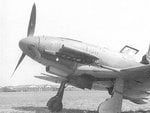- Thread starter
- #41
CharlesBronson
Senior Master Sergeant
For the maniac.
To be effectively synchronised, a gun required a short "lock time"; the delay between the gun receiving the message to fire and the cartridge actually firing. This had to be as short as possible, in order to provide the precision needed to avoid hitting the propeller.
A lot of MGs and cannon (the Scotti included) fired from an open bolt; the starting position for the gun was with the chamber empty and the bolt held back. When the gun received the message to fire, the bolt was released, began to move forwards, picked up a cartridge, loaded it into the chamber, locked up the action and, only then, fired. This took far too long. There were a few open-bolt guns which retained a separate control of the firing pin (the MG 17 was one) which did enable them to be synchronised.
The Breda S.A.F.A.T used a copy or the Browning short recoil mechanism...the Browning Short recoil system used in the M2/M3 caliber.50 and the M1917 M1919 cal 30 is a closed bolt short recoil mechanism.
I dont have any Idea what is your source for the Breda shooting from an open bolt but is simply WRONG.
Hai capito bene ?
To be effectively synchronised, a gun required a short "lock time"; the delay between the gun receiving the message to fire and the cartridge actually firing. This had to be as short as possible, in order to provide the precision needed to avoid hitting the propeller.
A lot of MGs and cannon (the Scotti included) fired from an open bolt; the starting position for the gun was with the chamber empty and the bolt held back. When the gun received the message to fire, the bolt was released, began to move forwards, picked up a cartridge, loaded it into the chamber, locked up the action and, only then, fired. This took far too long. There were a few open-bolt guns which retained a separate control of the firing pin (the MG 17 was one) which did enable them to be synchronised.
The Breda S.A.F.A.T used a copy or the Browning short recoil mechanism...the Browning Short recoil system used in the M2/M3 caliber.50 and the M1917 M1919 cal 30 is a closed bolt short recoil mechanism.
I dont have any Idea what is your source for the Breda shooting from an open bolt but is simply WRONG.
Hai capito bene ?














![AS14foto[1].jpg](/forum/data/attachments/71/71025-1991f70bf1fbf3c238ed348797ec2f18.jpg)



